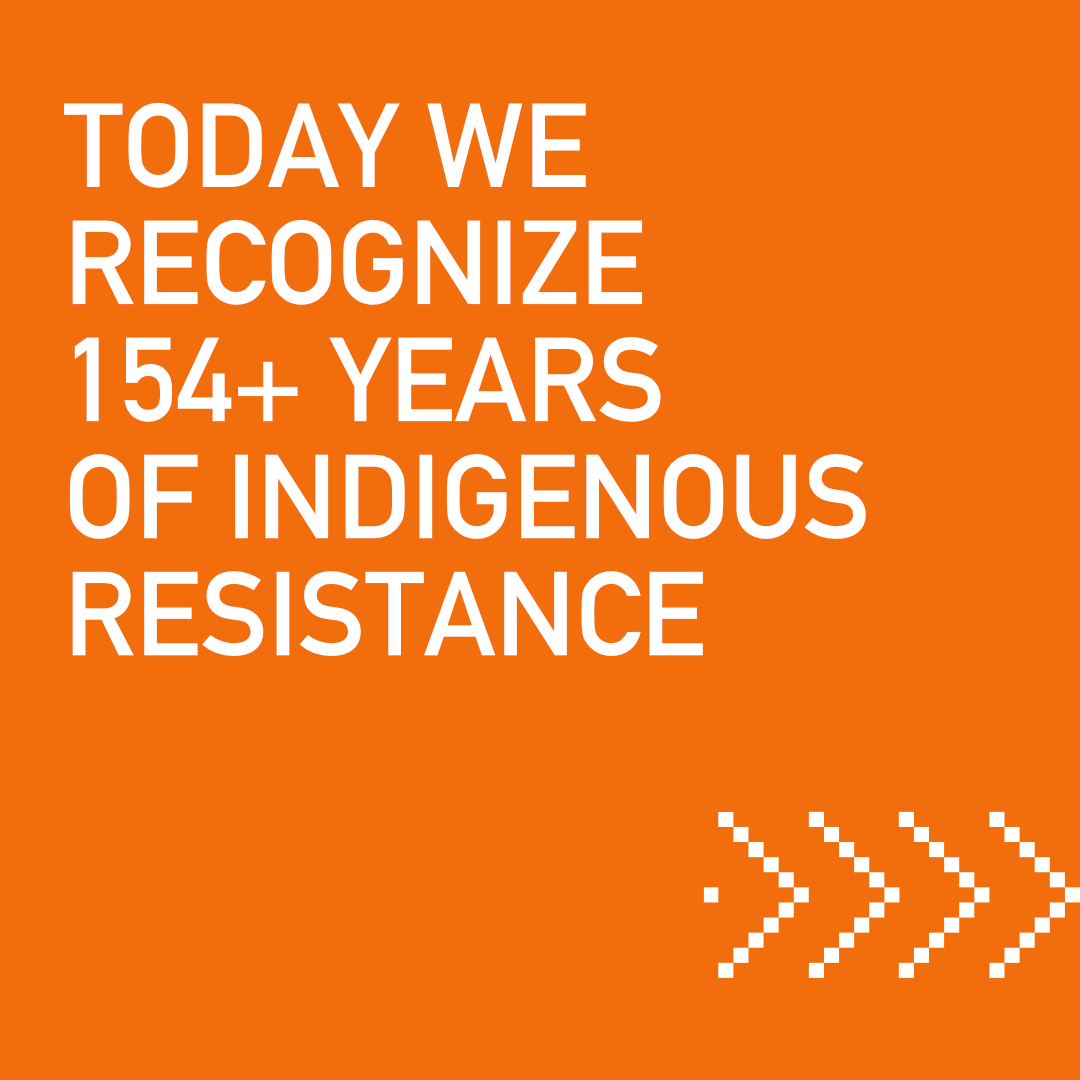Today we recognize 154+ years of Indigenous resistance.
In particular, Gallery 101 recognizes the 154+ years of ongoing resistance on the unceded Algonquin-Anishinaabe terrority on which we operate. The following is a land acknowledgement written by author, advocate, public speaker and artist Dr. Lynn Gehl, PhD, Algonquin Anishinaabe-kwe:
Currently we are on Algonquin Anishinaabeg traditional territory. The Algonquin were one of the first Indigenous Nations that Champlain recorded as he travelled up the Kichesippi, now called the Ottawa River.
Algonquin territory consists of 48 million acres inclusive of rivers, lakes, boreal forests, rock, trees, four legged, winged, and finned. Through the creation of Upper and Lower Canada, now Ontario and Quebec, and through the French surrendering and ceding land that they did not own, the Algonquin Anishinaabeg have been divided along the very river that once united us. Through the overlay of Canada the nation state and the imposition of a provincial federal order, the Algonquin are divided by language, law, and religion. While 39 million acres is in Quebec, 9 million is in Ontario.
Through processes of genocide inherent in processes of colonization, which continues today, the Algonquin have been relegated to small plots of land. There are ten federally recognized communities made up of registered status members: one in Ontario and nine in Quebec. As suggested these communities reside on only small fractions of the larger Algonquin Anishinaabeg traditional territory. Pikwàkanagàn First Nation’s land base consists of a mere 1,561 acres; Barriere Lake only 59; while Wolf Lake has been denied a land base altogether. There are also many communities in Ontario, made up of mostly non-status members, that have been more formally organized to accommodate the federal government’s need to define Indigenous rights in narrow terms and they all lack their own collective land bases known as reserve lands.
The Kichesippi has been subject to the logging, hydroelectric, nuclear power, and the fishing and sport hunting industries. These industries have clogged the Great River, flooded important landscapes, and are currently dumping radio-active particles in the river. What is more, the nuclear industry is also warming the river using the water to cool down nuclear reactors.
Although the Algonquin Anishinaabeg were emissaries during the 1764 Treaty at Niagara, and many of the men fought on the side of the British during the 1776 American revolution, and during WW1 and WW2, Algonquin were and are continually denied the jurisdiction to their land and resources.
Indigenous knowledge philosophy is a life way that situates humans within a broader context of the natural world versus a religion selectively practiced. Within this philosophy, the Four Sacred Elements ‒ Water, Rock, Wind, and Fire ‒ are valued as more intelligent. As such, places where they intersect are sacred. In addition, while many people think Indigenous people of Turtle Island lack a tradition of symbolic literacy, in actuality the Anishinaabeg inscribed stories, knowledge, and important messages within the land and waterscapes of their territory. Akikpautik is where Creator placed the First Sacred Pipe, the ultimate expression of Reconciliation between Nations, Humans, and the Natural World.
Today there are more non-status than status Algonquin and many of us reside outside of our traditional territory.[Shared with permission from LynnGehl.com]
We share this to remind us of the histories, and acknowledge the ongoing extractions, of resources and Indigenous peoples from this land. As settlers, immigrants, and newcomers we can support the resistance by learning these realties and acknowledging our powers to amplify Indigenous calls to action in our communities and with elected officials.
We also recognize and celebrate the work of the following Indigenous-led organizations and initiatives based on these territories. Their contributions to celebrating Indigenous cultures and nourishing Indigenous communities are vital parts of the ongoing resistance.
- Odawa Friendship Centre: Celebrating over 33 years of dedicated services to the Aboriginal community
- Asinabka: Film and media festival featuring artists from Indigenous communities across Turtle Island and around the world.
- A7G - Assembly of Seven Generations: Youth-led organization focused on cultural support and empowerment based in traditional knowledge and Elder guidance.
- Project Nibi: Student-led social enterprise working with Indigenous communities to monitor and take ownership of the safety of their drinking water.
- Thunderbird Sisters Collective: Intergenerational collective spreading Indigenous cultures through events, podcasts, market place pop-ups and a Youth Council.
- NAC Indigenous Theatre: The first National Indigenous theatre department in the world, rooted in Indigenous self-determination and self-representation.
- OPL Indigenous Language Collections in Cree, Inuktitut, and Ojibwe: featuring books, music, films, and digital titles found online and at the Main and St.Laurent Branches
- Inuuqatigiit Centre: An Inuit cultural learning environment for urban Inuit children, youth, and families.
- Wabano Centre for Aboriginal Health: Healthcare services from a wholistic Indigenous perspective
- Tungasuvvingat Inuit: An Inuit-specific service provider offering community supports for Inuit of all ages.
- Minwaashin Lodge: An Indigenous Women’s Support Centre for survivors of domestic and other forms of violence, and those suffering the effects of the residential school system
